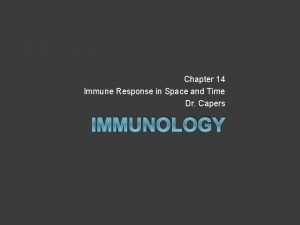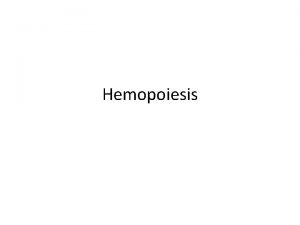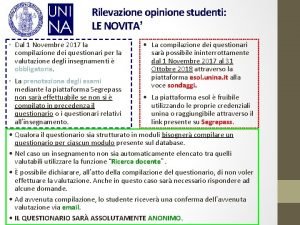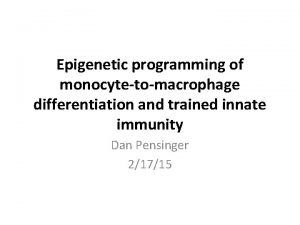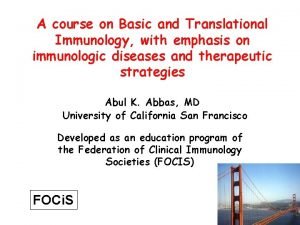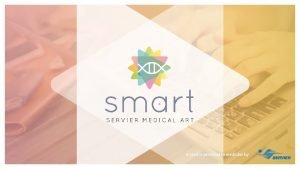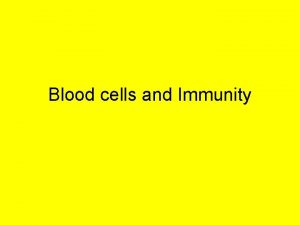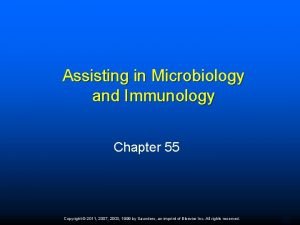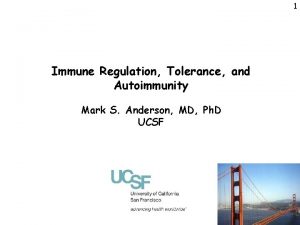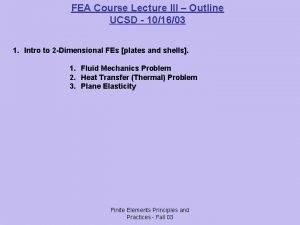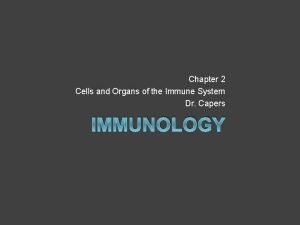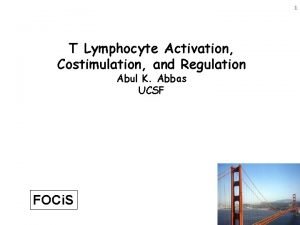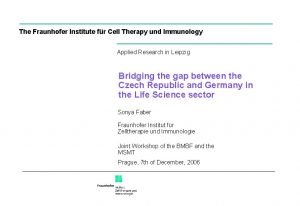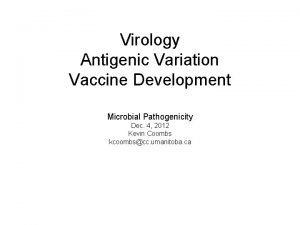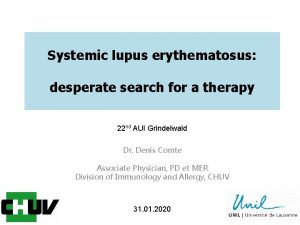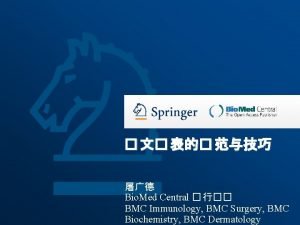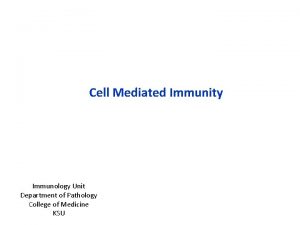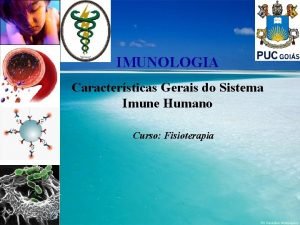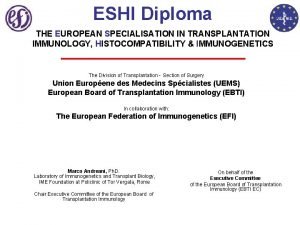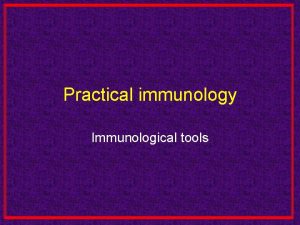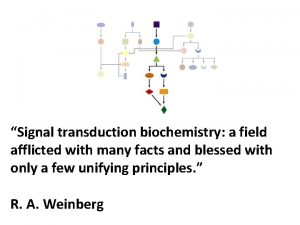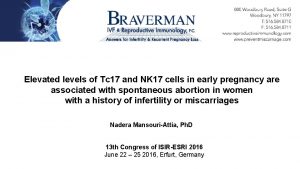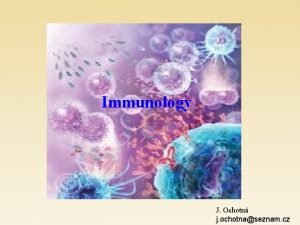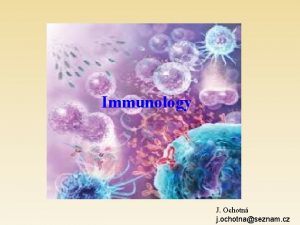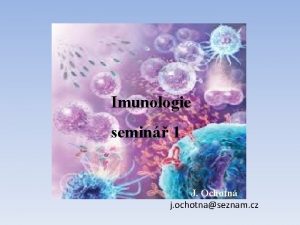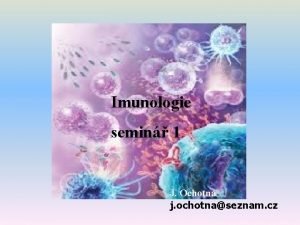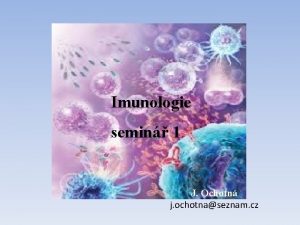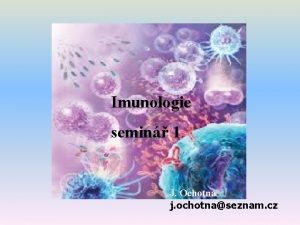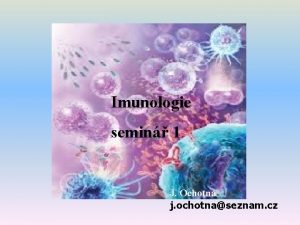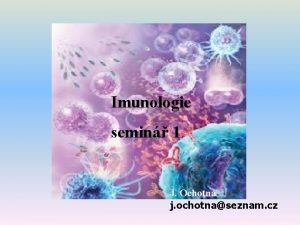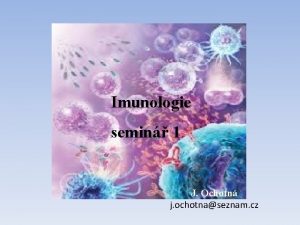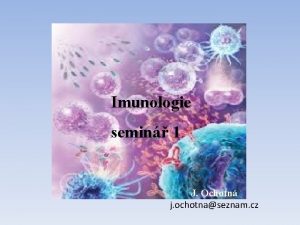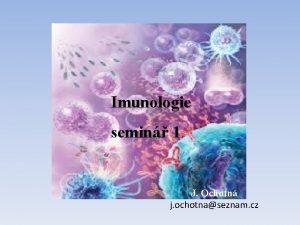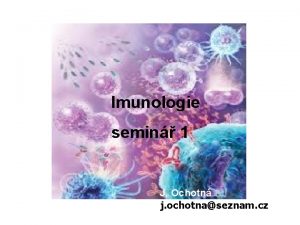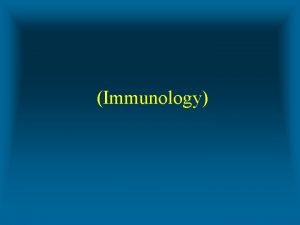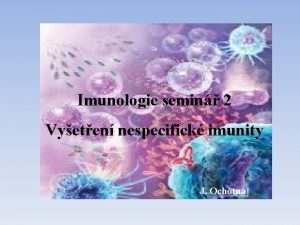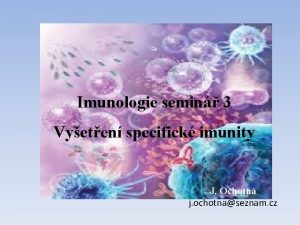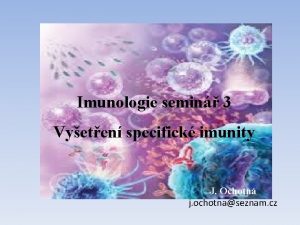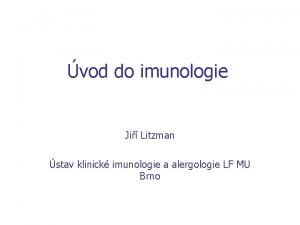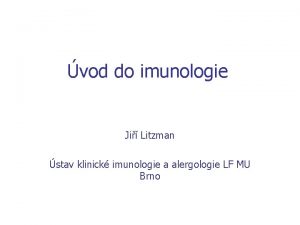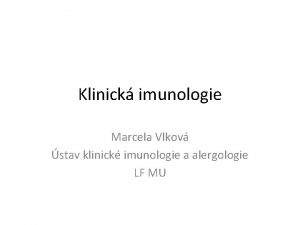Imunologie Immunology semin 1 J Ochotn j ochotnaseznam























































- Slides: 55

Imunologie Immunology seminář 1 J. Ochotná j. ochotna@seznam. cz

http: //uia. fnplzen. cz/

Immune system J. Ochotná

The main functions of the immune system Immune system belongs to the basic homeostatic mechanisms Defense Autotolerance Immune surveillance

Antigen (immunogen) * substance that can induce a humoral and/or cell-mediated immune response * predominantly proteins or polysaccharides * molecules >5 k. Da (optimal size of antigen is about 40 k. Da) * autoantigen * exoantigen * allergen

Haptens * small molecules, that are able to induce specific immune response only after the establishment to the macromolecular carrier (separate haptens are not immunogenic) * typically drugs (eg penicillin antibiotics, hydralazin)

Interaction antigen – antibody Binding site of antibody (paratop) form non-covalent complexes with the corresponding part on antigen molecule (epitope) * antigen-antibody complex is reversible

Types of antigens according to antigen presentation 1) thymus dependent antigens * more frequent, especially protein Ag * for induction of humoral immune response is necessary cooperation with TH cells * assistance implemented in the form of cytokines produced by TH cells

Types of antigens according to antigen presentation 2) thymus independent antigens * can induce antibodies production directly without the participation of T lymphocytes * mainly bacterial polysaccharides, lipopolysaccharides and polymer forms of proteins (e. g. Haemophilus, Str. pneumoniae) T-independent pathway

Superantigens * stimulate lymphocytes polyclonaly and massively (5 -20%) * massive activation of T lymphocytes (massive cytokine release) can cause shock * e. g. bacterial toxins (Staph. aureus, Str. pyogenes, Pseud. aeruginosa)

Sequestered antigens * autoantigens that are normally hidden from the immune system and therefore unknow (e. g. the lens of the eye , testes, brain) * if they are "uncovered" by demage, can induce the immune response (one of theories of autoimmune processes)

Components of the immune system

Components of the immune system * Lymphoid tissues and organs * Cells of the immune system * Molecules of the immune system

Lymphoid tissues and organs * are linked with the other organs and tissues by network of lymphatic and blood vessels Primary lymphoid tissues and organs * bone marrow, thymus * maturation and differentiation of immunocompetent cells immature lymphocytes acquire here their antigenic specificity *

Secondary lymphoid tissues and organs * meeting place of immunocompetent cells with Ag spleen lymph nodes and their organized clusters (tonsils, appendix, Peyer patches in the intestine MALT (mucous associated lymphoid tissue)

Cells of the immune system * development of red and white blood cells begin at yolk sack, then haematopoiesis travels to fetal liver and spleen (3 to 7 month gestation), then bone marrow has the main hematopoietic function * all blood cells arise from a pluripotent stem cell (CD 34) * haematopoiesis is regulated by cytokines


Immune mechanisms

Nonspecific (innate) immune mechanisms * non-adaptive, innate * evolutionarily older * no immunological memory * in the presence of pathogens react quickly, in minutes (based on molecules and cells which are in the body prepared in advance) * component cellular – granulocytes (neutrophils, eosinophils, basophils), monocytes (macrophages, DC), NK cells, mast cells humoral - complement, interferons, lectins and other serum proteins

Specific (adaptive) immune mechanisms * adaptive, antigen-specific * evolutionarily younger * have immunological memory * development of a full-specific immune response takes several days even weeks * component cellular - T lymphocytes (TCR) humoral - antibodies

Phagocytosis

Phagocytosis = ability to absorb particles from the surroundings Professional phagocytes * protect the body by ingesting harmful foreign particles, bacteria, and dead cells * neutrophilic granulocytes, monocytes, macrophages and DC

Professional phagocytes granulocytes - defense against extracellular pathogens - able to perform effector functions immediately macrophages - removal of own apoptotic cells, defense against certain intracellular parasites, APC - fully functional after activation by cytokines (IFNg, TNF) Macrophage

The migration of phagocytes in damaged and infected tissues 7% of peripheral neutrophils and phagocytes 93% neutrophils and phagocytes in the bone marrow * in place of damage phagocytes are captured on endothelium (due to inflammatory cytokine expression of adhesion molecules is higher)

Phagocytosis * the first interactions with adhesion molecules slows the movement of neutrophils - roling * then there is a stronger link between endothelial cells and leukocytes and subsequent penetration between endothelial cells to the tissue - diapedesis (or extravasation) * phagocytes direct their movement to the site of inflammation by chemokines (IL-8, MIP-1 a and , MCP-1, RANTES, C 3 a, C 5 a, bacterial products. . . )

Receptors on phagocytes PAMPs (pathogen associated molecular patterns) PRR (pathogen recognition receptors) * TLR receptors (binds bacterial lipoproteins, lipopolysaccharides, bacterial DNA…) * mannose receptor * galactose receptor * CD 14 (binds bacterial LPS) * scavenger receptors (bind phospholipids on the surface of apoptotic cells)

Opsonisation * enhances phagocytosis of an antigen * antigen is marked with opsonin * Opsonins - Ig. G, Ig. A, C 3 b, MBL, fibronectin, fibrinogen, CRP, SAP * Fc receptors on phagocytes (recognize antibodies linked to surface of micro-organism) * complement receptors (for binding C 3 b)

Phagocytosis

Degradation of ingested material * fagosome fusion with lysosomes - oxygen independent (lysozyme, defensines, serine proteases, myeloperoxidase, acidic p. H…) * activation of membrane NADPH oxidase - oxygen dependent (superoxide, hydrogen peroxide, hypochlorous acid) * production of nitric oxide (NO) by macophages

Secretory products of phagocytes * IL-1, 6, TNF (systemic response to inflammation) * IL-8 (chemokine) * IL-3, GM-CSF (control haematopoiesis) * TGFa, TGF (tissue regeneration) * metabolic products of arachidonic acid (prostaglandins, prostacyclin, leukotrienes and thromboxanes)

Neutrophils have three ways of attacking pathogen: phagocytosis, degranulation and the formation of NETs

Complement

Complement * system of about 30 serum and membrane proteins * complement components are present in the serum in inactive form * complement activation has cascade character * complement proteins are synthesized in the liver, less by tissue macrophages and fibroblasts * the main complement components: C 1 -C 9 (C 3 is the central component) * other complement components: factor B, factor D, factor P * regulatory proteins: C 1 - inhibitor, factor I, factor H, DAF, MCP,

Complement functions * Opsonization (C 3 b) * Chemotaxis (C 3 a, C 5 a) * Osmotic lysis (MAC C 5 b-C 9) * Anafylatoxins (C 3 a, C 4 a, C 5 a)

Complement activation * Alternative pathway * Clasial pathway * Lektin pathway


Regulation of complement and protection of own cells § Activation of complement cascade is controlled by the plasma and membrane inhibitors. Anaphylatoxin inactivator MCP DAF Protectin

Complement regulation § C 1 inhibitor (C 1 -INH) – inhibits C 1; if missing→ HAE § factor I with cofactors: MCP (membrane cofactor protein), CR 1, factor H – C 3 b, C 4 b cleavage § DAF (decay-accelerating protein)-degradation of C 3 and C 5 convertase

Complement regulation § factor S (vitronectin) – inhibits complex C 5 b. C 6 § CD 59 (protectin) - prevents the polymerization of C 9 § anaphylatoxin inactivator (CPN)- inactivates anafylatoxins (C 3 a, C 4 a, C 5 a)

Complement receptors * Bind fragments of complement components CR 1 - on various cells - removing of immunecomplexes CR 2 - on B lymphocytes and FDC - activation of B cells CR 3, CR 4 - on phagocytes - participation in opsonization, adhesion

Basophils and mast cells and their importance in immune responses

Mast cells § Mucosal mast cells - in the mucous membranes of respiratory and gastrointestinal tract, participate in parasitosis and allergy § Connective tissue mast cells - the connective tissue, in parasitosis and allergy are not participating

Mast cell functions § Defense against parasitic infections § Responsible for the early type of hypersensitivity (allergic reaction) § Apply during inflammation, in angiogenesis, in tissue remodeling § Regulation of immune response

Mast cell activation Mast cells degranulation can be stimulated by: § Antigen or allergen through cross-linking of Ig. E Fc receptors § anafylatoxins (C 3 a, C 4 a, C 5 a) § TLR

Mast cell activation by cross-linking of Ig. E Fc receptors § Establishing of multivalent antigen (multicellular parasite) to Ig. E linked to highaffinnity Fc receptor for Ig. E (Fc RI) § Aggregation of several molecules Fc RI § Initiate mast cell degranulation (cytoplasmic granules mergers with the surface membrane and release their contents) § Activation of arachidonic acid metabolism (leukotriene C 4, prostaglandin D 2) § Production of cytokines (TNF, TGF , IL-4, 5, 6. . . )

Activation schema of mast cell

Secretory products of mast cells § Cytoplasmatic granules: hydrolytic enzymes, heparin, chondroitin sulphate, histamine, serotonin § Arachidonic acid metabolites (leukotriene C 4, prostaglandin D 2) § Cytokines (TNF, TGF , IL-4, 5, 6. . . )

Histamine § vasodilation § increased vascular permeability § bronchoconstriction § increases intestinal peristalsis § increased mucus secretion

Basophils § Differentiate from myeloid precursor § Are very similar to mast cells by the receptor equipment, content of granules, the mechanisms of stimulation and functions § Play role in inflammation, regulation of immune responses, in allergic reactions, they are responsible for the emergence of anaphylactic shock § In high numbers at the sites of ectoparasite infection


Complement – clasical pathway https: //www. youtube. com/watch? v=vb. WYz 9 XDt Lw Complement – alternative pathwayhttps: //www. youtube. com/watch? v=qga 3 Wn 76 d 9 w Complement https: //www. youtube. com/watch? v=5 Ao 36 HNv wvw Immune reaction https: //www. youtube. com/watch? v=G 7 r. Qu. FZx. V QQ

Alternative complement pathway * C 3 component of complement spontaneously breaks into C 3 b and C 3 a * C 3 b can covalently bind on the surface of microorganism * to bound C 3 b join a factor B, which is cleaved by factor D to Ba and Bb, resulting complex C 3 b. Bb is stabilized by factor P and functions as an alternative C 3 convertase * C 3 convertase cleaves C 3 to C 3 a (chemotaxis) and C 3 b, which binds to the surface of the microorganism (opsonization), or gives rise to other C 3 convertases * from some C 3 convertases form C 3 b. Bb. C 3 b that act as an alternative C 5 convertase, which cleaves C 5 to C 5 a (chemotaxis) and C 5 b (starts terminal lytic phase)

Classical complement pathway * Can be initiated by antibodies (Ig. M, Ig. G, except Ig. G 4) or by CRP, SAP , which are bound to antigen * C 1 binds to antibodies that have already attached themselves to antigen , change its conformation and get proteolytic activity - starts cleave proteins C 4 and C 2 * fragments C 4 b and C 2 a bind to the surface of the cell and create the classic C 3 convertase (C 4 b. C 2 a), which cleaves C 3 to C 3 a and C 3 b * then creates a classic C 5 convertase (C 4 b. C 2 a. C 3 b) that cleaves C 5 to C 5 a and C 5 b

Lectin complement pathway * is initiated by serum mannose binding lectin (MBL) * MBL binds to manose, glucose or other sugars on the surface of some microbes, after the bindins starts cleave C 4 and C 2 * this way is similar to the classical pathway

Terminal (lytic) phase of the complement cascade C 5 b fragments creates a complex with C 6, C 7 and C 8, the complex dive into the lipid membrane of the cell and attached to it into a circle 13 -18 molecules of C 9, thus create pores in the membrane and cell can lysis (G-bacteria, protozoans, some viruses). Most microorganisms is resistant to this lytic effect of complement (protection by cell wall).
 Pcams immunology
Pcams immunology Antigen antibody
Antigen antibody Wiki
Wiki Neutrophil extracellular traps
Neutrophil extracellular traps Nature reviews immunology
Nature reviews immunology Abbas basic immunology
Abbas basic immunology Servier medical art immunology
Servier medical art immunology Nature reviews immunology
Nature reviews immunology Assisting in microbiology and immunology
Assisting in microbiology and immunology Central tolerance and peripheral tolerance
Central tolerance and peripheral tolerance Fea course
Fea course Pals immunology
Pals immunology Molecular immunology ppt
Molecular immunology ppt Abbas basic immunology
Abbas basic immunology Fraunhofer institute for cell therapy and immunology
Fraunhofer institute for cell therapy and immunology Nature reviews immunology
Nature reviews immunology Lupus
Lupus Guangde tu
Guangde tu Kuby immunology
Kuby immunology Trends in education
Trends in education Diploma in immunology
Diploma in immunology Phagocyte
Phagocyte Avidity in immunology
Avidity in immunology Nature reviews immunology
Nature reviews immunology 17 tc
17 tc American academy of allergy asthma and immunology 2018
American academy of allergy asthma and immunology 2018 Tumor immunology
Tumor immunology
